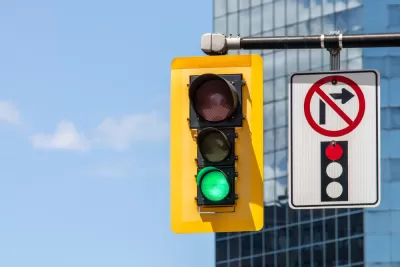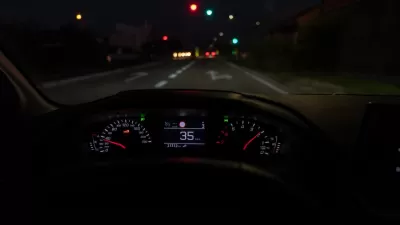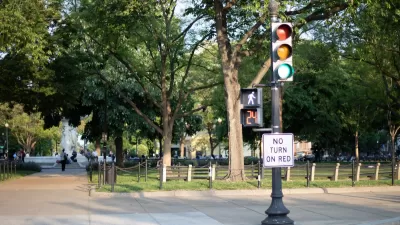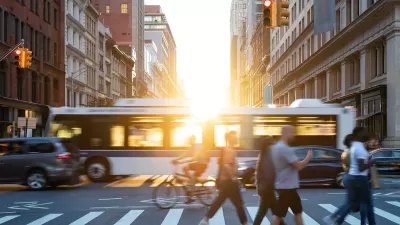Born out of the oil crisis of the 1970s, the practice of turning right on red lights is a uniquely American—and uniquely dangerous—custom.

Most American drivers don’t think twice about making a right turn on a red light (RTOR). For decades, it’s been the status quo in many cities. But as Abigail Weinberg explains in an illuminating Slate article, the habit is relatively new and, to many experts, obsolete and dangerous. According to Weinberg, “The data on right-turn-on-red crashes might be scarce, but the existing studies suggest that these types of collisions—while rare—frequently involve a pedestrian or cyclist.”
The practice was born out of the 1970s oil crisis, when the government sought to reduce emissions by minimizing idling at red lights. “A provision of the 1975 Energy Policy and Conservation Act said that, in order for states to receive federal assistance for mandated conservation programs, they had to enact ‘a traffic law or regulation which, to the maximum extent practicable consistent with safety, permits the operator of a motor vehicle to turn such vehicle right at a red stop light after stopping.’”
However, the policy has never been proven to significantly reduce emissions or idling time. “Take into account the growing number of hybrid and electric cars, and RTOR makes even less sense.” Meanwhile, electric vehicles have the potential to increase RTOR crashes due to their quicker acceleration.
Quoting transportation engineer Bill Schultheiss, Weinberg concludes that making right turns on red illegal, while a “minor enough inconvenience” for drivers, could be “a baby step in creating an urban environment that is more supportive of walking, bicycling, and transit.”
Today, more cities are moving to ban RTOR. New York City has a ban, and Washington, D.C. could soon follow, if legislation passed by the district’s council is approved by the mayor and Congress. Ann Arbor, which delayed its vote on the issue earlier this year, voted to ban RTOR at 50 intersections in its downtown.
FULL STORY: The Surprising History—and Deadly Consequences—of Right Turn on Red

Alabama: Trump Terminates Settlements for Black Communities Harmed By Raw Sewage
Trump deemed the landmark civil rights agreement “illegal DEI and environmental justice policy.”

Planetizen Federal Action Tracker
A weekly monitor of how Trump’s orders and actions are impacting planners and planning in America.

How Atlanta Built 7,000 Housing Units in 3 Years
The city’s comprehensive, neighborhood-focused housing strategy focuses on identifying properties and land that can be repurposed for housing and encouraging development in underserved neighborhoods.

Report: Zoning Reforms Should Complement Nashville’s Ambitious Transit Plan
Without reform, restrictive zoning codes will limit the impact of the city’s planned transit expansion and could exclude some of the residents who depend on transit the most.

Judge Orders Release of Frozen IRA, IIJA Funding
The decision is a victory for environmental groups who charged that freezing funds for critical infrastructure and disaster response programs caused “real and irreparable harm” to communities.

‘Clybourne Park’ Sets Stage for Housing Equity Discussions
Clybourne Park, a play exploring race, real estate, and community tensions, can set the stage for discussion on the lasting impacts of housing discrimination, gentrification, and the fight for affordability.
Urban Design for Planners 1: Software Tools
This six-course series explores essential urban design concepts using open source software and equips planners with the tools they need to participate fully in the urban design process.
Planning for Universal Design
Learn the tools for implementing Universal Design in planning regulations.
Caltrans
Smith Gee Studio
Institute for Housing and Urban Development Studies (IHS)
City of Grandview
Harvard GSD Executive Education
Toledo-Lucas County Plan Commissions
Salt Lake City
NYU Wagner Graduate School of Public Service





























